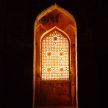The Konyak settlement of Longwa is on the beaten path. It’s one of the few places in northeastern Nagaland which sees a steady stream of visitors. The village, which straddles the border between India and erstwhile Burma, is the focus of tourism in the Konyak dominated part of the world.
But this is an industry built around a dying culture. Longwa is “the place” to meet the last of the tattooed headhunters, but these men haven’t conducted raids since the 1960s or early 70s. The number of men who took enemy heads in Longwa is dwindling, and they have all been photographed countless times. It was an odd experience for me coming across a few of these old warriors as I walked down the street. It was rather like seeing a celebrity at an airport. The old headhunter’s faces were instantly recognizable because they had appeared in numerous publications over the past few decades. But now they had a few more wrinkles than in their pictures.
There is a great deal of value in photographing these ambassadors from another era, and perhaps even more in interviewing them, writing down their stories, and recording their traditions. But they’re also really old guys who have had tourists and photographers shoving cameras in their faces for the last 20 years. Many of them have physical ailments, can’t hear, or can’t walk unassisted. Most clearly don’t have much longer to go. One still detects the occasional glimmer of their old fierceness. But one also senses that by this point these headhunting celebrities have spent nearly as much time playing the part of fierce warriors for tourists as they did running around making war in their youths.
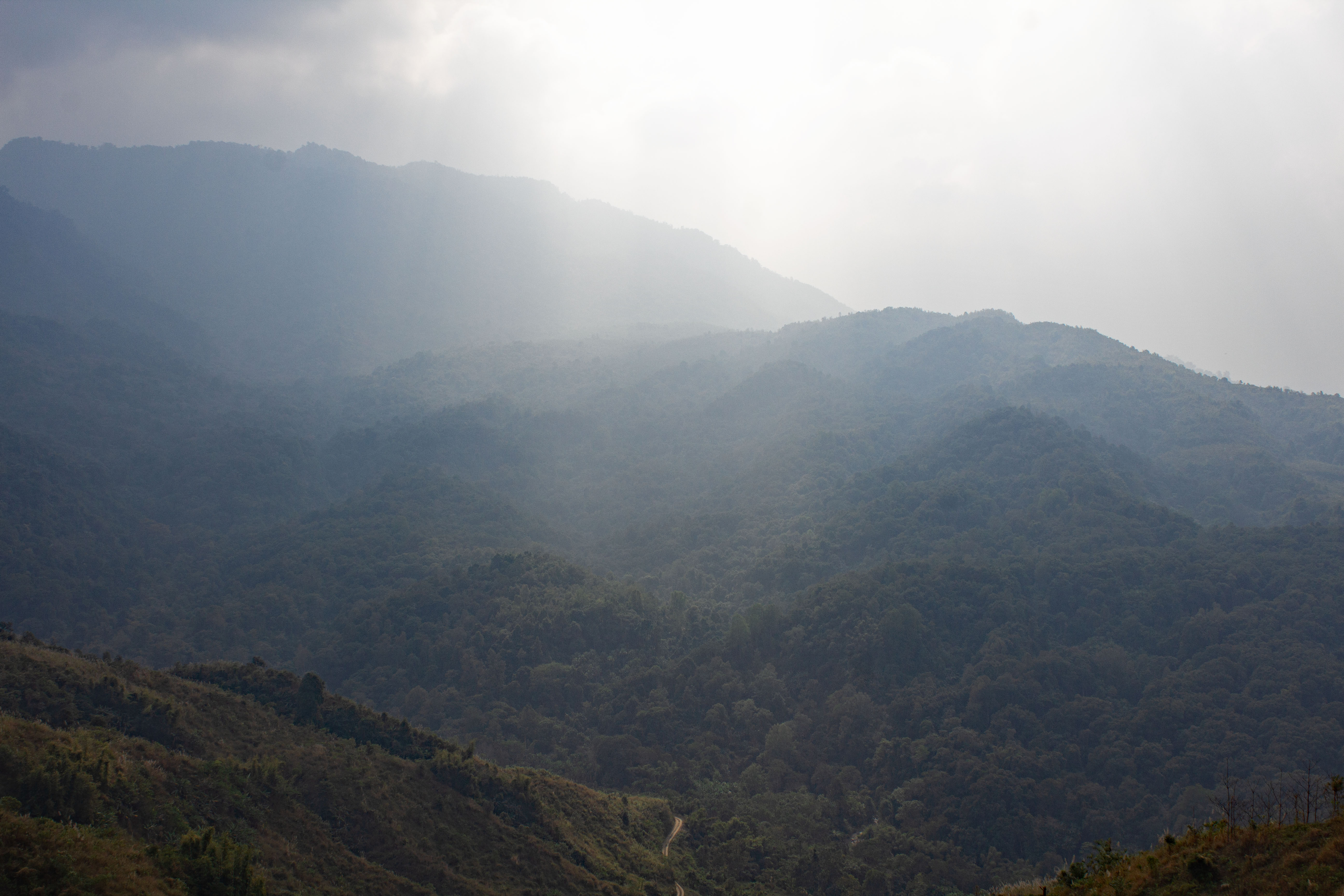
A view toward the ridges climbing up to Longwa and the border with Burma. This photo was taken as I walked from the village of Longzang to Longwa. It was sunny when I left Longzang, but as I climbed to Longwa I approached a layer of grey misty clouds that never really broke until I left Longwa a few days later. Longwa is situated along a saddle on a high ridge at an altitude of around 1500 meters. The ridge has some of the highest terrain in the vicinity, which means it has a distinct microclimate. For the four days I stayed there, Longwa was concealed in a demoralizing cold mist. Not the best of conditions for landscape photography.
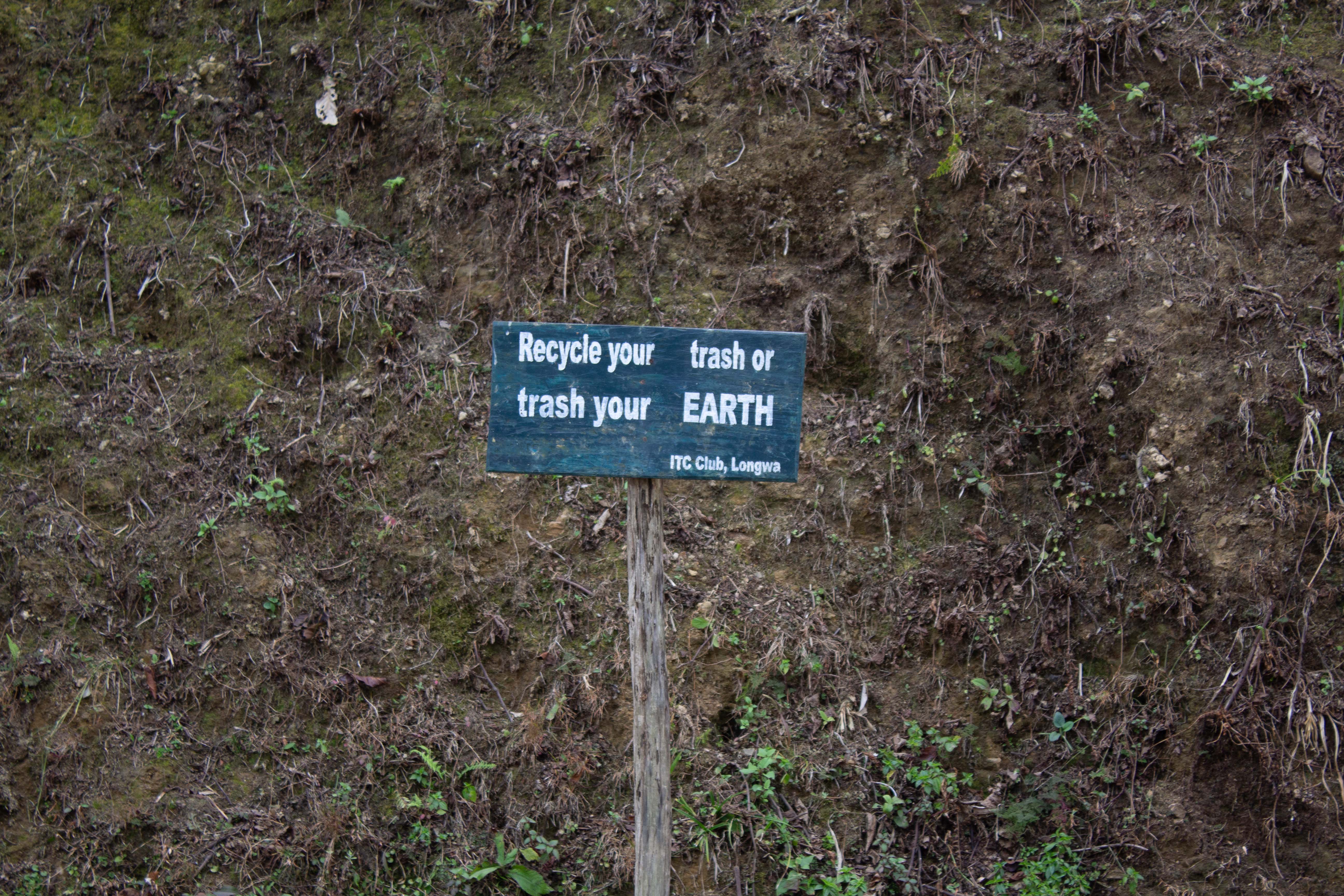
Helpful advice for the tourists.
The headhunters, by virtue of their unique life stories and their picturesque tradition of tattooing their faces to mark success in battle, have managed to earn significant income for themselves and their families while also generating a whole cultural tourism industry which has served to make Longwa one of the more prosperous Konyak Naga villages. The fact that these men cut off the heads of their fellow Konyaks is in part responsible for Longwa having one of the best roads in the district. Travelers come every day to see them, and infrastructure has been built to help facilitate this (and also to help reinforce the village’s strategic position on India’s border).
One certainly doesn’t begrudge the warriors their income, nor the village for having uplifted itself. But one does wonder what will become of Longwa when the warriors have passed on. In only a few years “the last of the headhunters” will become “the last headhunter,” and then the old days of inter-village war among the Konyaks will pass beyond living memory. Will the tourists still come then?
I hope so, though the years ahead for Longwa are uncertain. The village may have benefitted immensely from tourism, but its geopolitical location is precarious. The king, or angh, of the village rules Konyak settlements in both India and Burma. The village itself is dissected by the international border, and many of its people have dual citizenship. The king’s longhouse is divided lengthwise by two nations. And they are two very different nations. India is in the ascendant, with ever increasing development, a larger and larger share of the world’s economy, and even an overachieving space program. Burma on the other hand is sinking deeper into its endless cycle of civil war and violence, with a kaleidoscopic array of anti-government forces having recently captured large swathes of territory from the country’s dysfunctional military government. And, exactly in the middle of all of this: The king of Longwa’s kitchen.
There is real talk of building a fence along the whole length Indo-Burmese border, a proposal which might prevent some of Burma’s dysfunction from leaking into India, but which would also cut the Konyak heartland in two, dividing families and no doubt badly alienating many elements of Naga society from Delhi. The proposal is not popular in Longwa. Guerilla warfare with Naga nationalist separatist movements (and drug cartels) across the borderlands only recently simmered down. The heavy-handed imposition of a border fence might not move things in a helpful direction.
Let’s all hope the Longwa’s biggest problem in the coming years is attracting tourists.
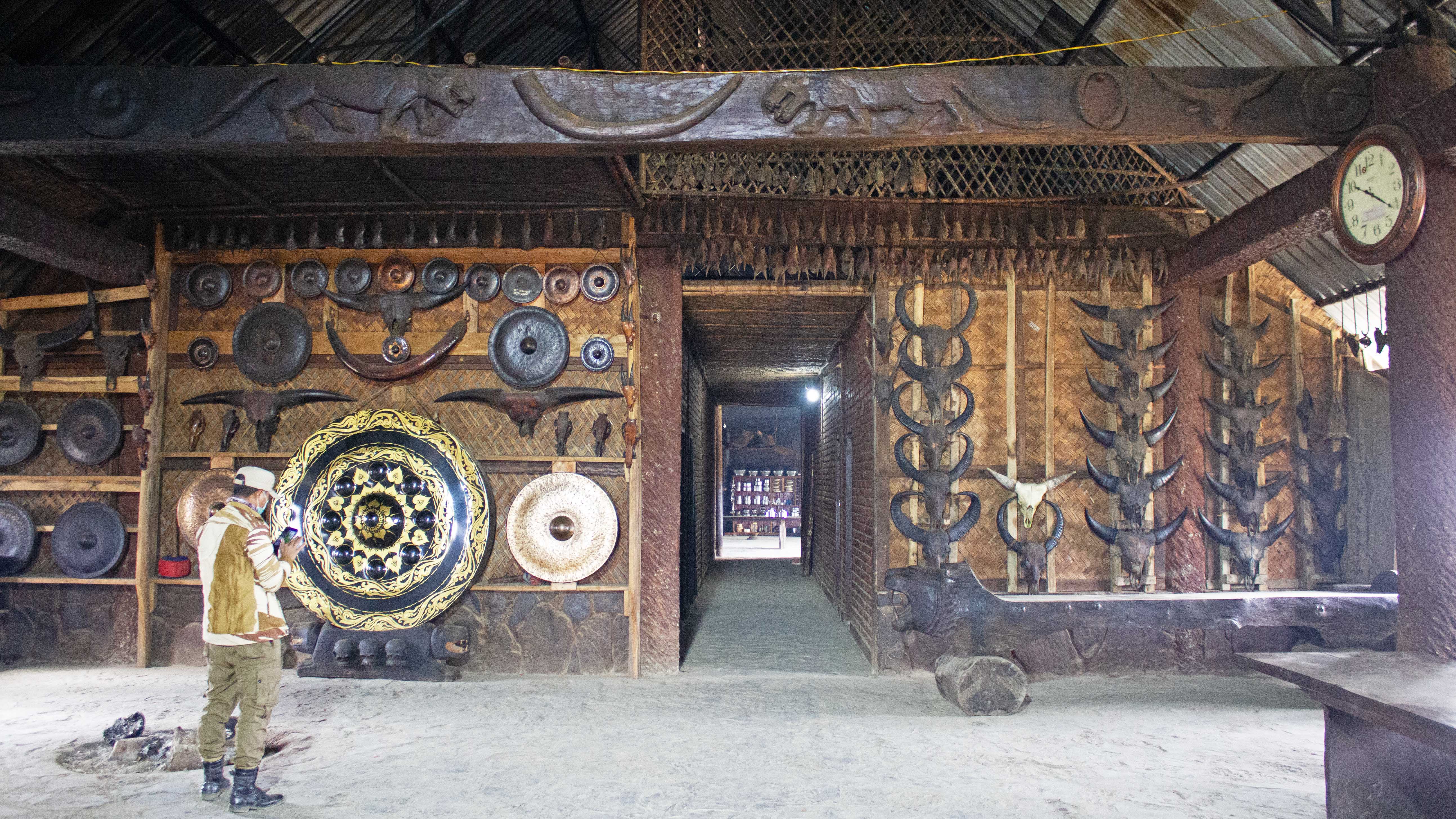
The inside of the king of Longwa’s longhouse. The left side of this photo is in Burma and the right side is in India.
My main objective in Longwa was not to meet its headhunters. I calculated that I would have better opportunities to come across old tattooed warriors in other, more obscure villages along my path later on. Rather, my goal was to seek out the living root bridges of the Konyaks, some of which I had learned existed in a nearby settlement called Nyahnyu (which I’ll cover in the next instalment of this series). An Israeli friend who I met in 2016 had hiked from Longwa to Nyahnyu, and along the way had unexpectedly encountered several living bridges. My goal was thus to trace my friend’s footsteps and see if the living bridges of Nyahnyu still existed. One day, I walked down to Nyahnyu from Longwa and, sure enough, crossed a living root bridge. Having done so, I planned to return to Nyahnyu a few days later and spend a few nights there.
Other than the headhunters, the top attraction in Longwa is the king’s longhouse. While the house is full of old Konyak artifacts and includes some traditional architectural features, most of the structure is very recent. I briefly visited Longwa one afternoon back in 2012, and back then the king’s house was an entirely traditional thatch and bamboo structure with a wooden post in the middle of the front hall marking the international border. It was reminiscent of other Konyak longhouses, with a dark, smoky, atmospheric, interior. Walking into it was like stepping back in time. But much has changed in Longwa over the last decade. The new, much fancier longhouse is made mostly of concrete, stone, and corrugated metal, though it still has a traditional layout. I don’t begrudge the king for having upgraded, and it’s worth pointing out that since the materials longhouses are made of degrade rapidly, they must be regularly changed out. There’s a sense in which no longhouse is truly a heritage structure. The most historical elements are the wooden beams, which I’m told can last many generations. At least some of these have been retained here.
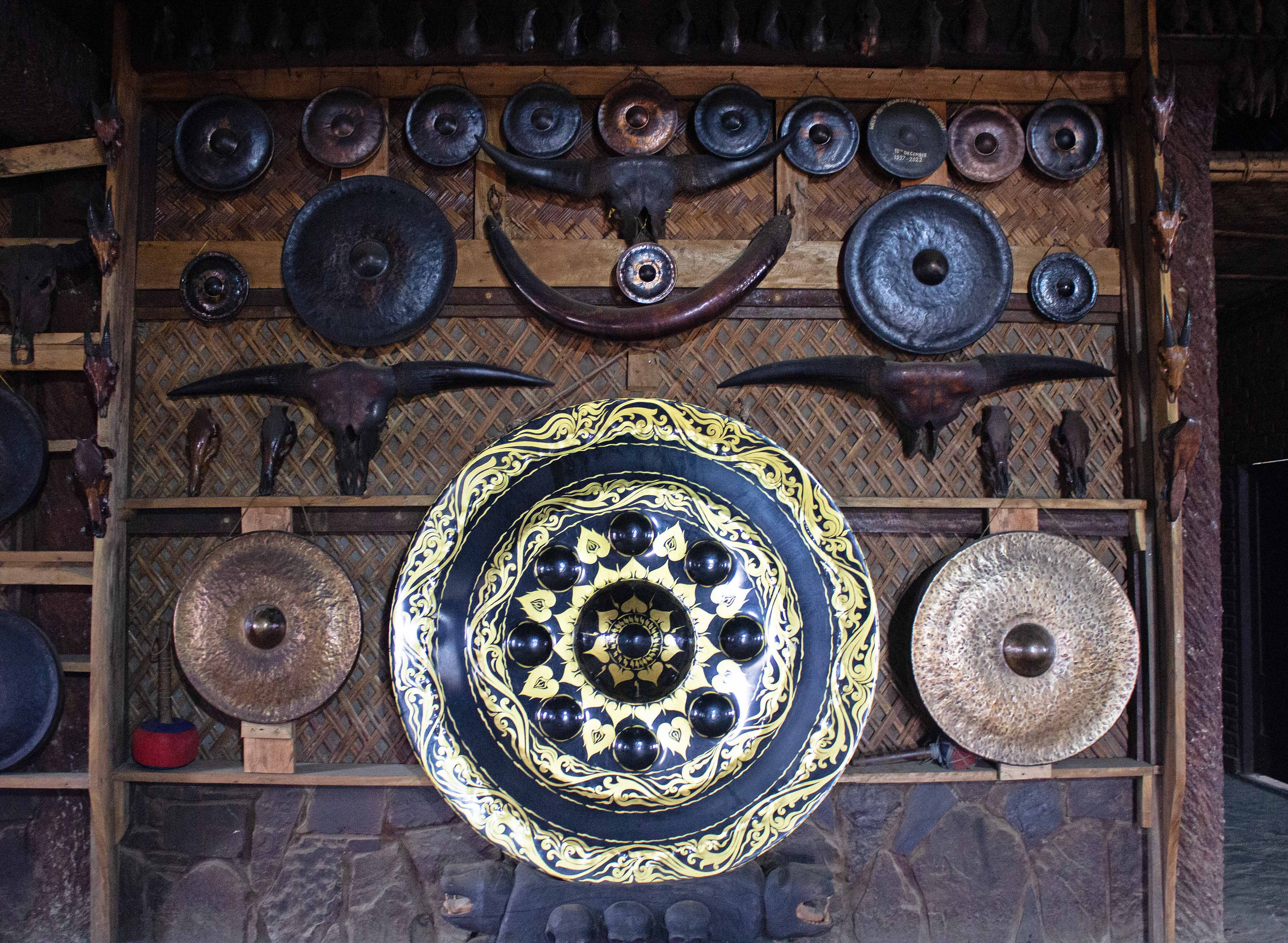
Impressive artifacts on display, including ceremonial gongs, mithun, goat, and wild boar skulls, along with an elephant tusk.
Still, when one spends a night at a traditional Konyak longhouse, such as the one in Longzang village, one senses that headhunting warriors might walk in the door at any minute bearing their grizzly trophies. In the smoke of the hearth, beneath the buffalo skulls and the rotting stuffed tigers, the 21st century seems to fade away like a weird dream.
The new king’s longhouse in Longwa gives off a very different vibe. While numerous impressive bits of Konyak culture are proudly displayed, they feel like museum exhibits. The building is as much a part of today’s India (less so today’s Burma) as it is a monument to the old days of the Konyaks. After all, it’s the headquarters of a king who bears significant responsibility over a number of settlements in two countries. It’s a modern building meant to deal with modern problems. The headhunting way of life celebrated on its walls feels like it has already receded from the realm of living culture into that of historical preservation.
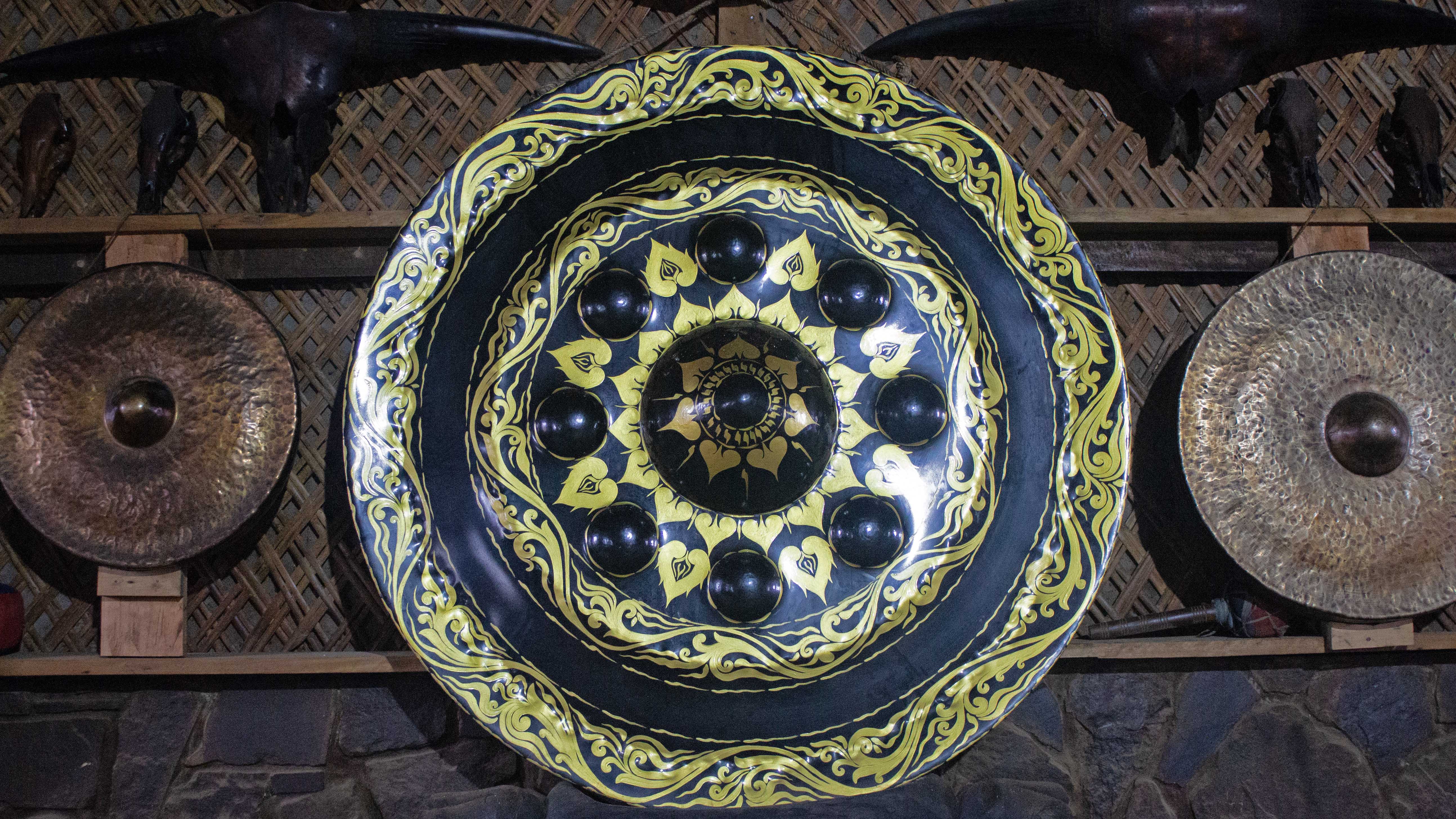
A huge ceremonial gong. You might have noticed that the gong is stylistically quite incongruous when displayed among the other assorted Konyak artifacts in the king’s longhouse. That’s because it’s the product of a completely different culture. It came from the rulers of lowland Burma, and was given to the Angh of Longwa as a gift from one royal family to another. (If anyone has any more detailed information on how the massive gong wound up in Longwa I’d be interested to hear it. What I know about it came from a few random snippets from guides.)
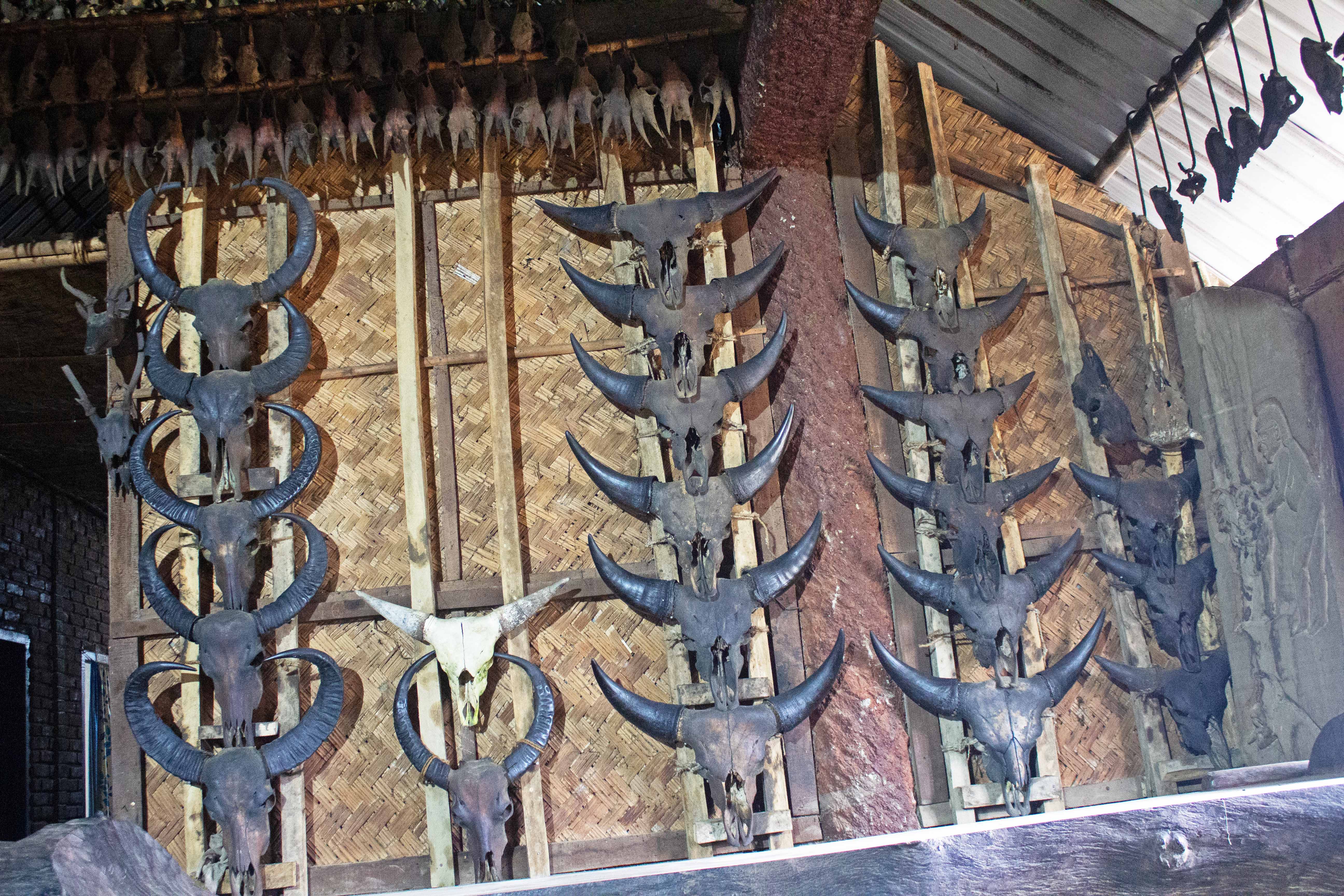
Skulls! What would a visit to a Konyak longhouse be without at least a few dozen? These are mithun, buffalo, and, above, goat skulls. The mithun skulls are the ones to the right with the shorter, less curved horns and the wider foreheads. The goat skulls are hanging up above.
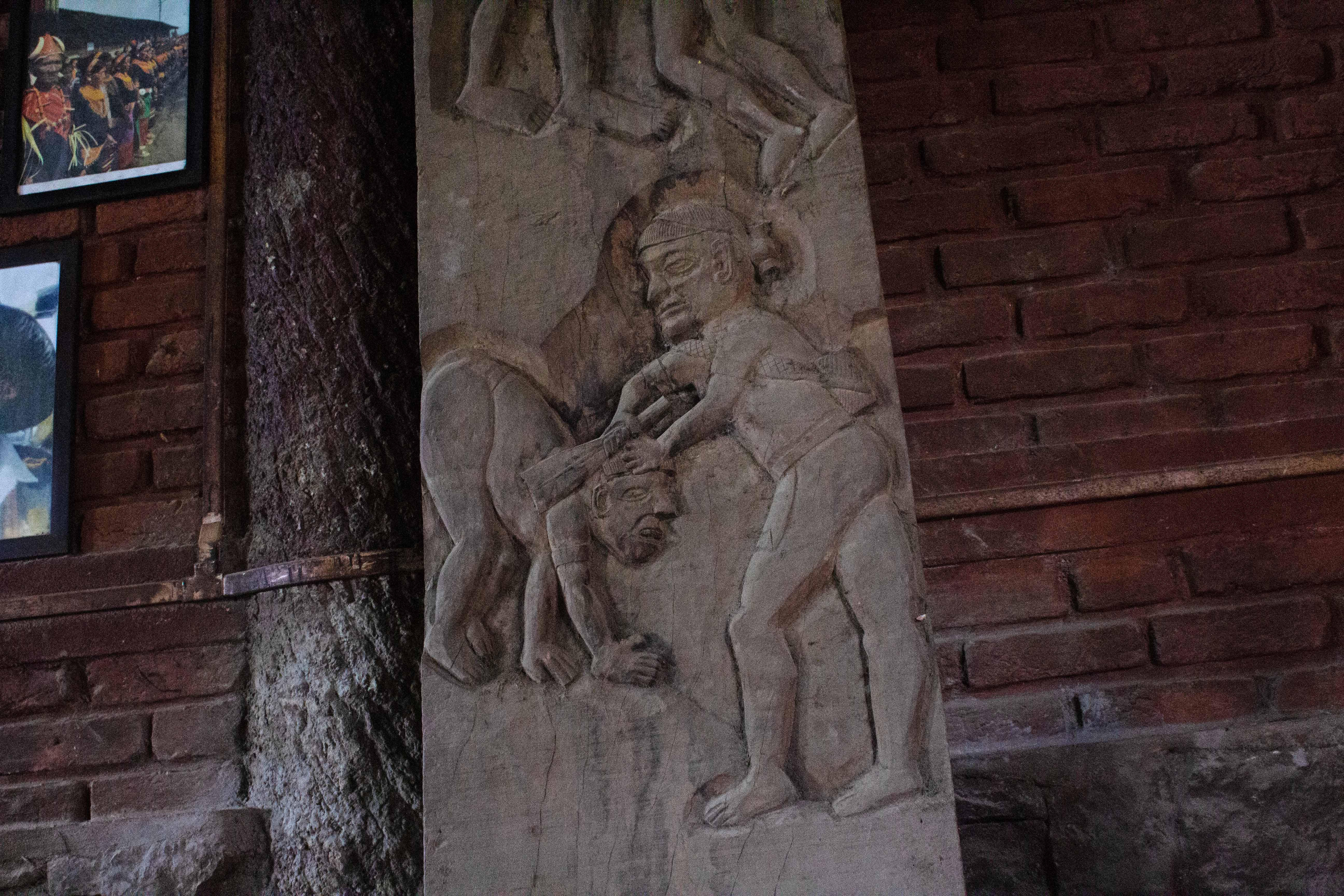
An old wooden carving of a Konyak warrior decapitating a fella. Even though traditional Konyak woodcarving art is relatively simple, it’s very effective in a ghastly sort of way. The guy getting his head cut off here looks most distressed, his expression skillfully rendered by whoever carved this. Now, I’m not sure I’d want this in my living room, but to each their own.
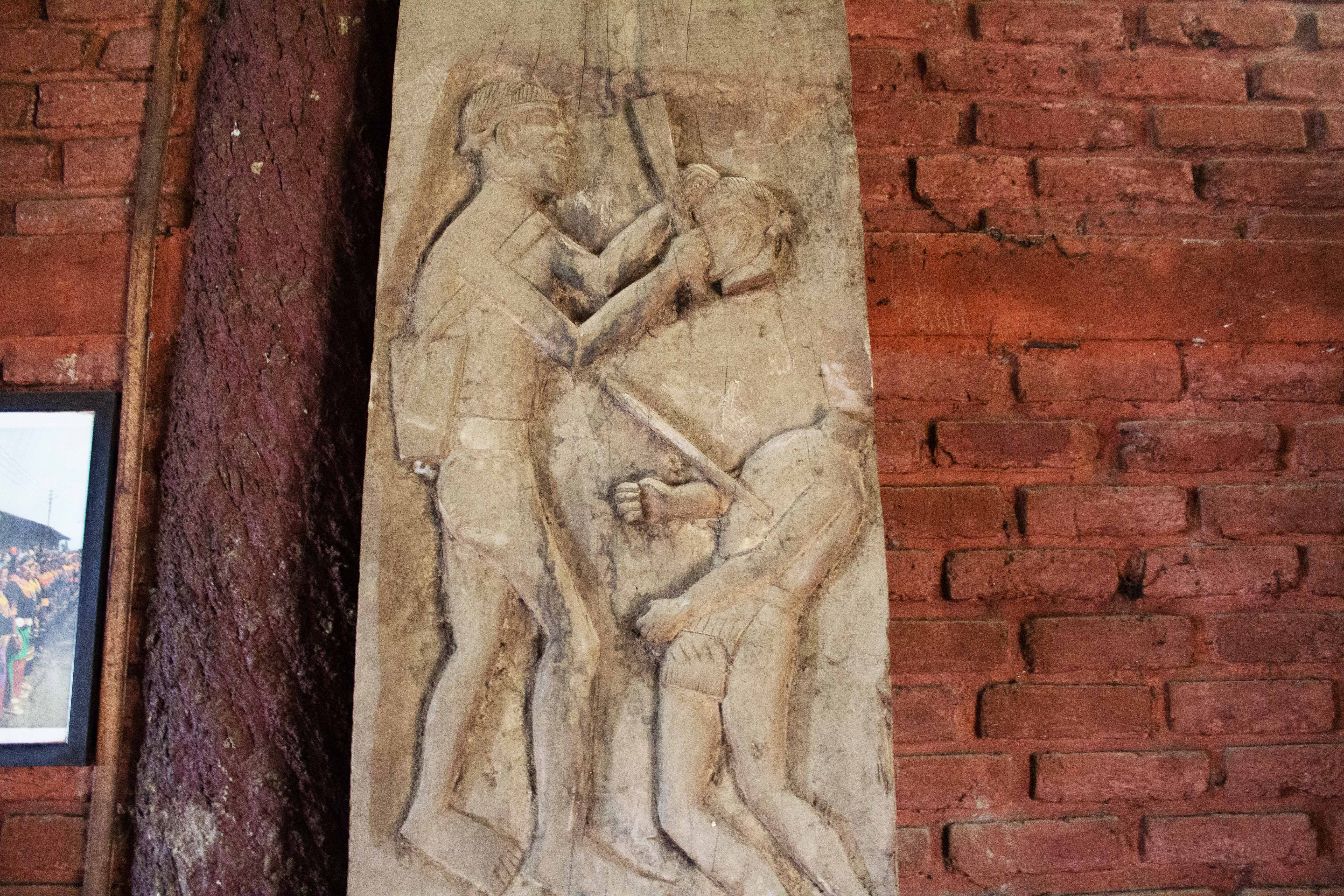
More decapitation!
On the last day I was in Longwa I wound up tagging along on a short tour of the village that one of the other guests at my homestay had arranged with a South Indian photographer based in London. Our guide was a young Konyak named Mansheih, who had a personal relationship with most of the surviving tattooed headhunters in the village. He had their phone numbers (or their relatives’ numbers) and so could call them up whenever curious outsiders were enroute. This gave the old guys time to don their dusty traditional warrior gear and prepare to start posing before the tourists showed up, as they had countless times over the past 20 years.
The tour was mostly for the benefit of the south Indian photographer, who had come all the way to Longwa explicitly to photograph the tattooed warriors for an art project in Europe. The photographer had a job to do, and since getting pictures of the warriors in Longwa wasn’t really my focus, I was mostly happy to stand back and let an extraordinarily odd scene unfold.
When one sees beautifully shot portraits of old Konyak headhunters, one doesn’t see what it took to produce these images. The viewer doesn’t know how much time the photographer spent setting up their gear, taking test shots, or moving their headhunter into better lighting. What makes the old Konyaks such engaging subjects is their fierceness and the sense that they come from a different era; they are people who have seen extraordinary things, have decapitated other human beings, and have witnessed the world transform around them. But now here they are being posed by some random dude with a fancy camera.
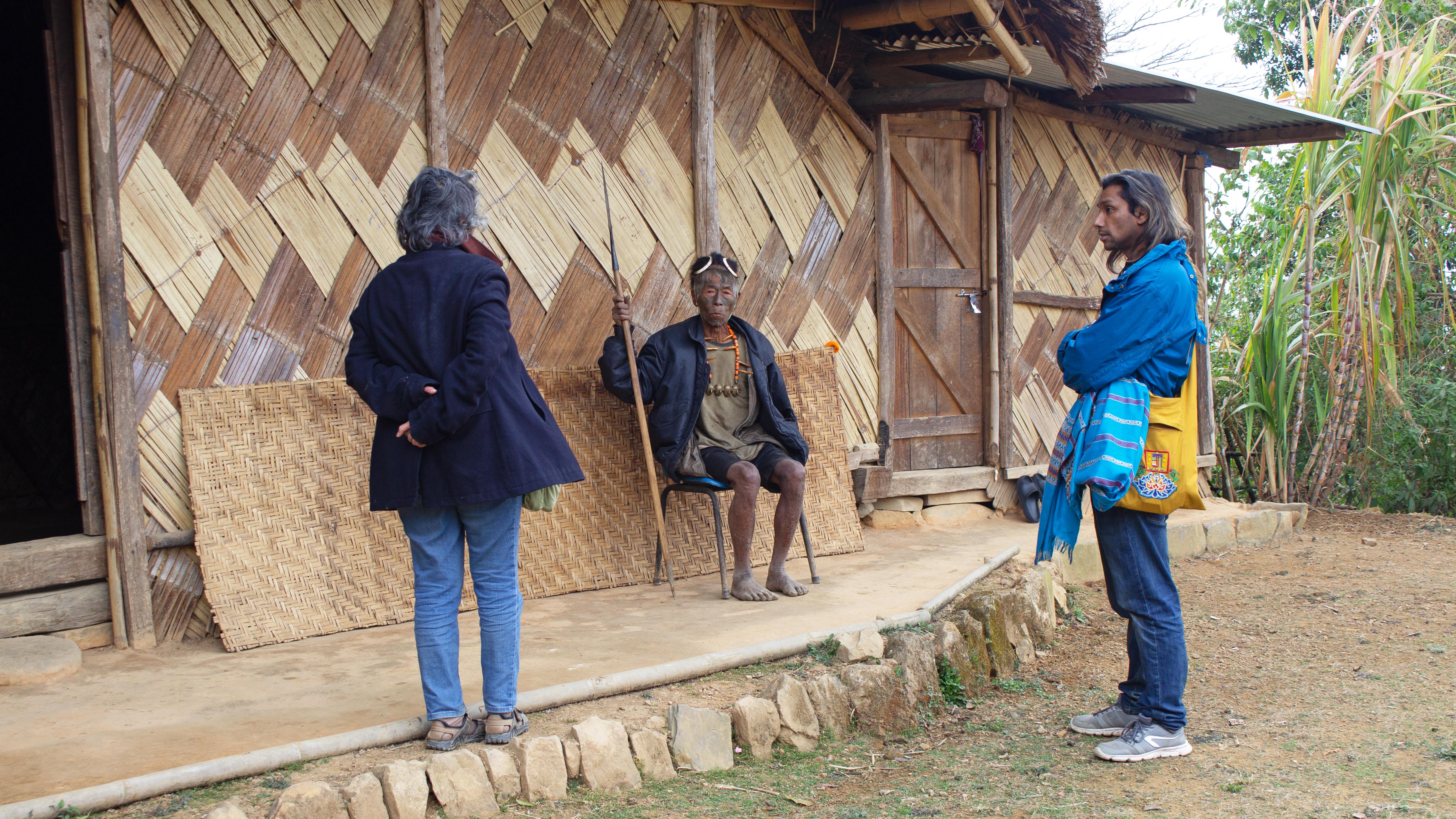
An 87-year-old headhunter sits around being an object of curiosity. The man must have extraordinary patience to have tourists gawk at him like this every day. Not that he wasn’t a good sport about it. As far as I can tell, he’s benefitted quite a bit monetarily from his recently discarded warlike culture. The photographer (the man to the right), was far more gracious and polite than people of his profession can sometimes be. On my first trip to Nagaland, I made the acquaintance of a European photographer who became deeply offended when he was asked to pay for the privilege of shoving his cameras in old guy’s faces. This was not well received by the headhunters whose culture he so eagerly sought to document. Fun times.
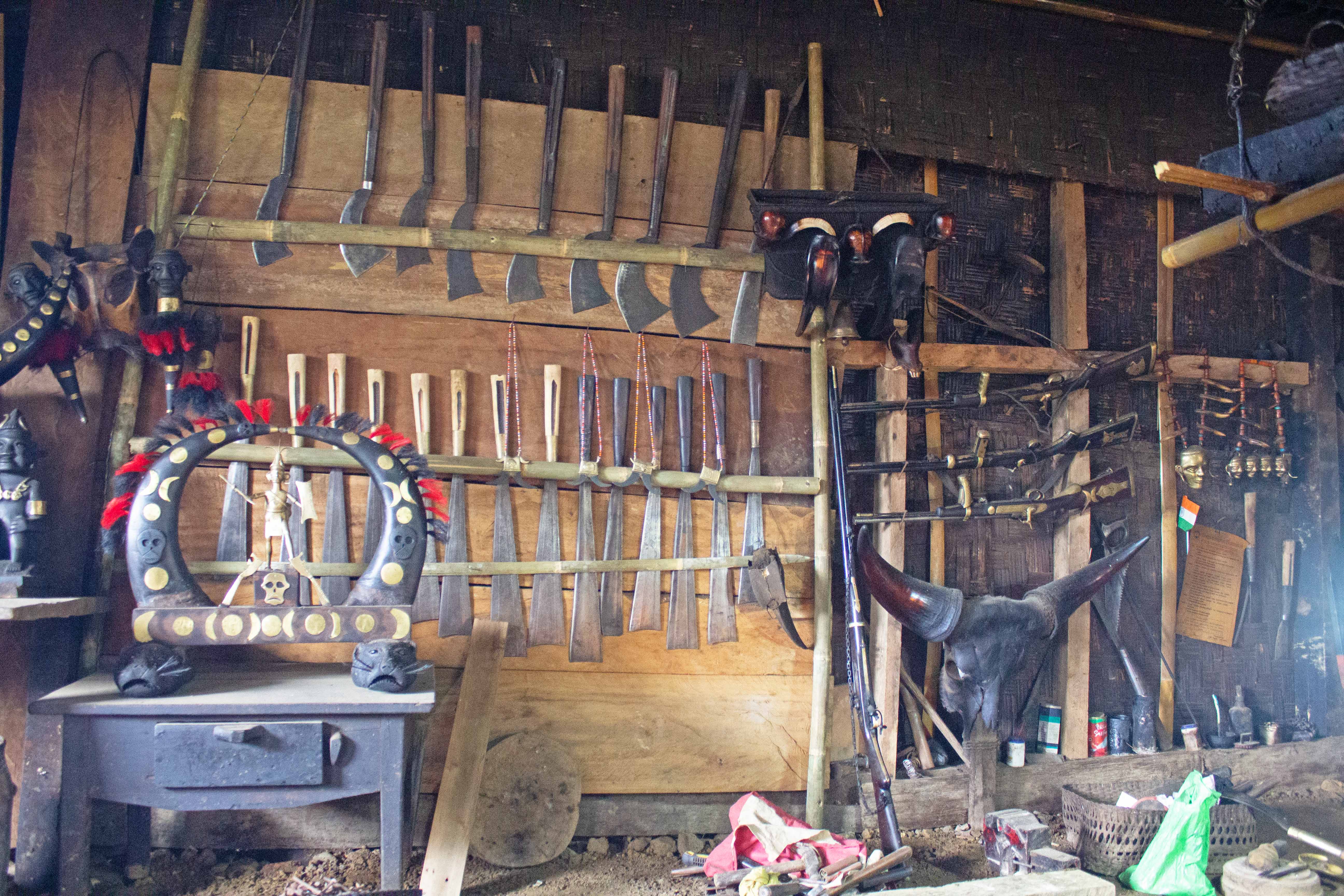
Inside a Konyak blacksmith’s shop that we visited in-between headhunters. This is a popular stop on the typical Longwa tourist route, and for good reason. The Konyak’s have a long tradition of forging their own weapons, including various kinds of knives and black-powder firearms. These are meant to be mostly ceremonial or decorative (or to be sold to tourists far richer than I), but the knives are certainly sharp.
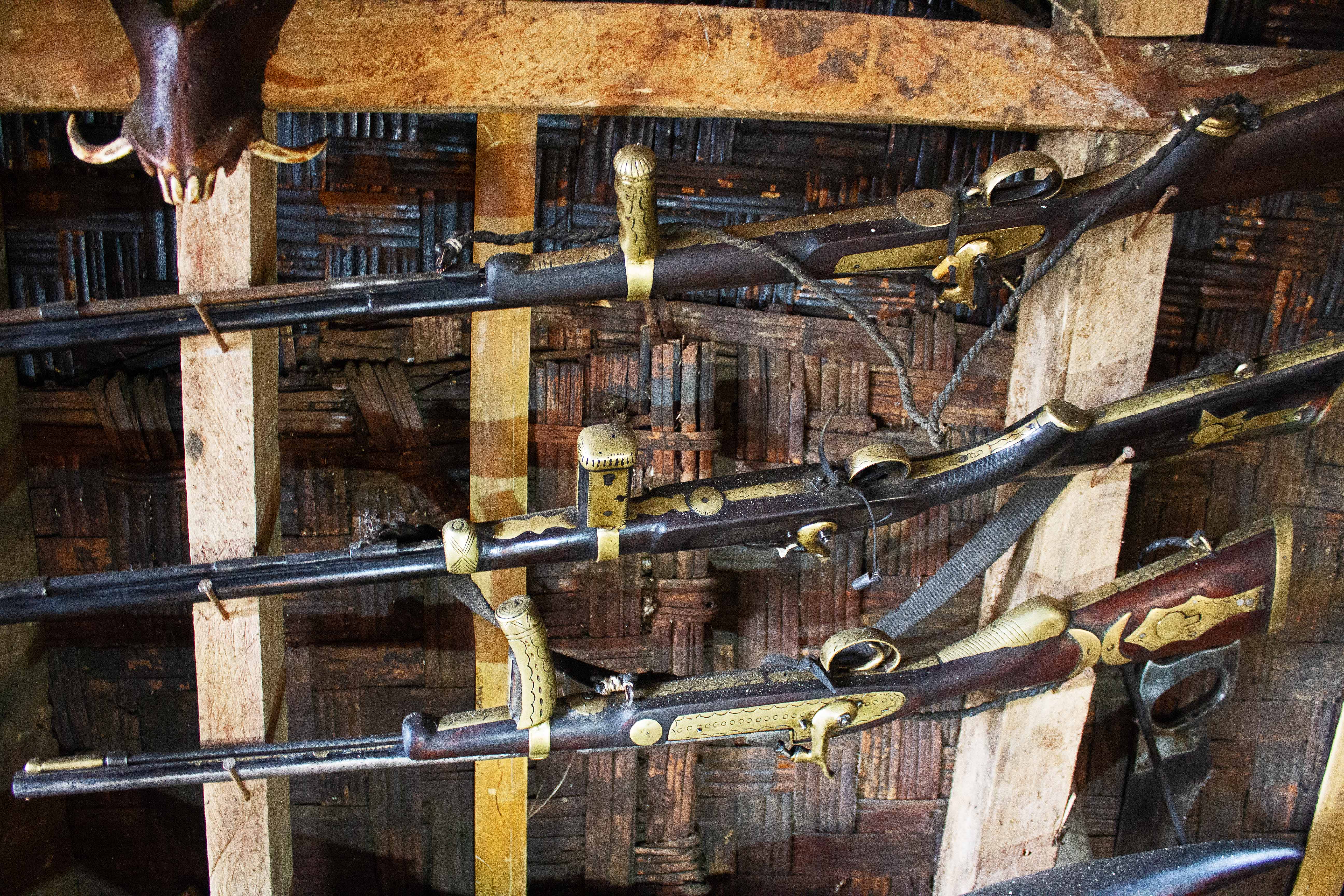
Konyak locally made black powder rifles. These are probably intended for use during celebrations, such as the Konyak spring festival of Aoleang, which I’m told involves a great deal of drinking and shooting guns in the air. One will often see Konyak men packing intimidating looking homemade guns when they’re out walking in the jungle, hoping to bag whatever game they’ve failed to hunt to extinction so far. In northeast Nagaland, the sound of black powder firearms being discharged out in the hills is a part of the ambient background noise.
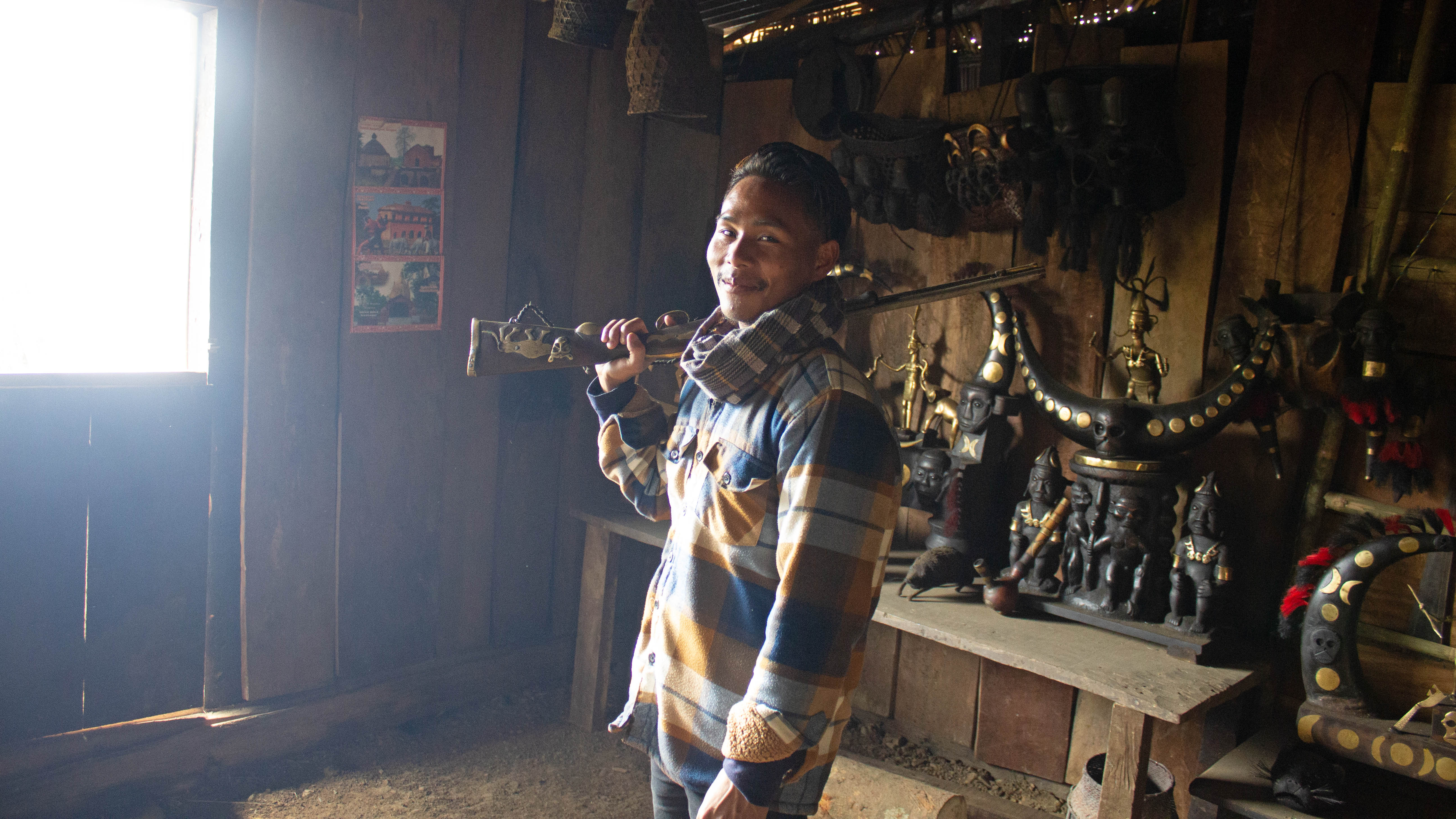
Manshieh, our truly excellent guide for an afternoon, with gun.
On the same ridge as Longwa, a few kilometers to the south and about 300 meters higher in elevation, is the satellite village of Longwa-Wasa. The road that connects the two settlements is very poor. At the time I visited it had been raining off and on, turning the road into a muddy track which was so badly rutted that vehicles driving up to Longwa-Wasa from Longwa could only get about three-quarters of the way before they were forced to give up and park while the passengers proceeded on foot.
The poor road conditions mean that Longwa-Wasa is far less developed than its more well known neighbor. This makes the trek up to it an interesting side-quest from Longwa, which for me had the advantage of connecting with several trails that lead down on the Indian side through thick jungle to Nyahnyu village, the next destination on my trek.
Now, as a foreigner, walking alone in this area is a bit of a dodgy proposition. Unlike in Longwa, where Indian security forces make it quite clear where India ends and Burma begins, on the road to Longwa-Wasa the international border is unmarked. Longwa-Wasa is ostensibly a village with two countries, but here there’s little to remind one that the settlement is anything other than Konyak Naga. Sadly, the security situation on the Burmese side requires foreigners to have their wits about them.
But these issues aside, my experiences with the people of Longwa-Wasa were uniformly very positive. They see far fewer tourists there than in Longwa, and as a rule the less tourists a place sees the nicer the locals will be to the few who bother to make the trip. I got invited to a wedding party that just happened to be going on when I showed up and was offered a huge plate of pork and rice with boiled vegetables. I find Naga food very agreeable. Foreigners often complain about the rice-based meals being essentially heaping plates of carbs, but as long as you’re spending all day walking around, all that energy gets burnt.
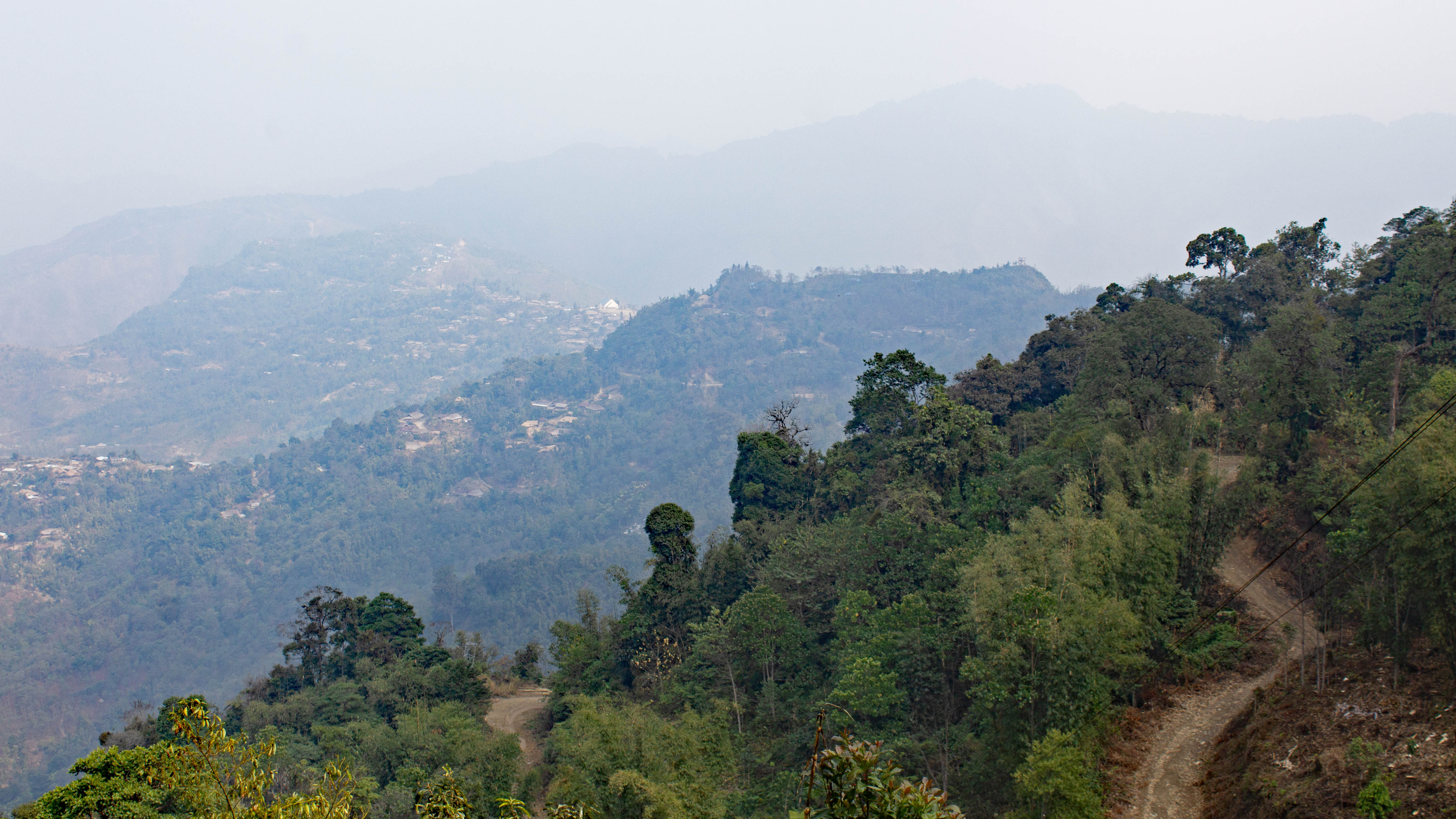
A view down onto Longwa from the road up to Longwa-Wasa. This was during one of the very few almost-sunny intervals I experienced during my stay in the area. It rained again a few hours after this photo was taken.
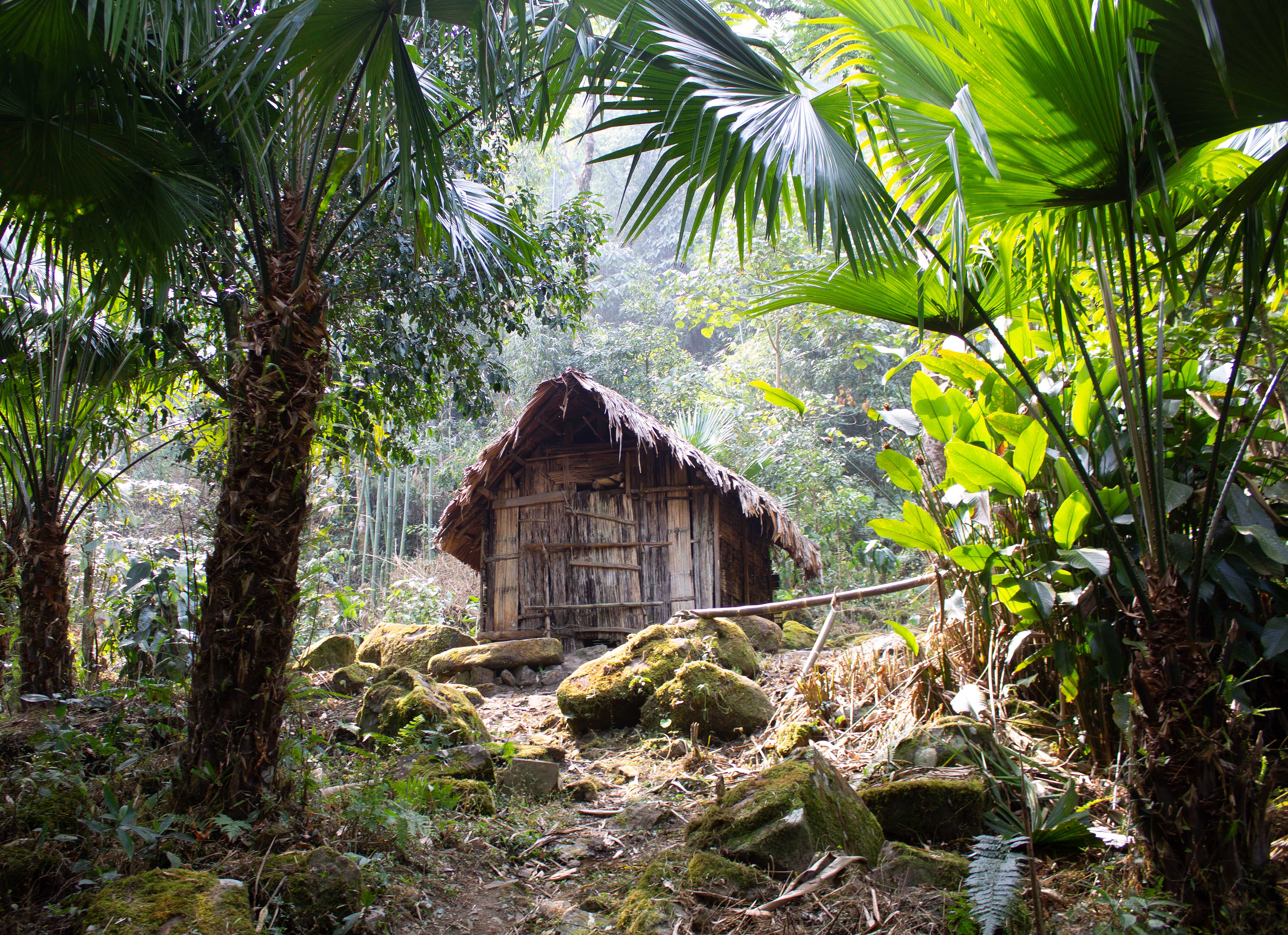
A jungle work hut built with vernacular construction techniques. This was up a side trail off of the Longwa-Wasa road.
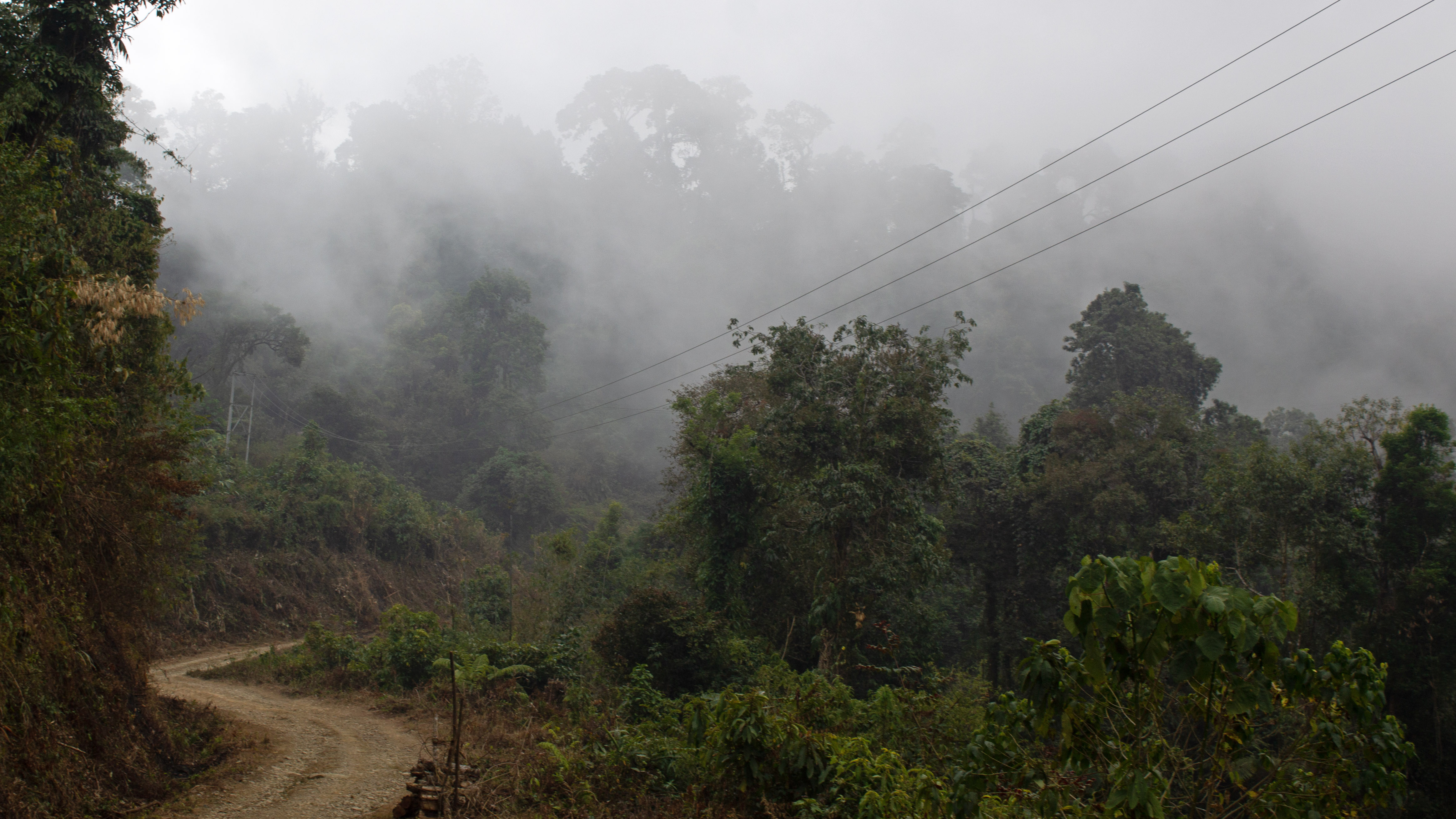
Climbing up into the cloud ceiling.
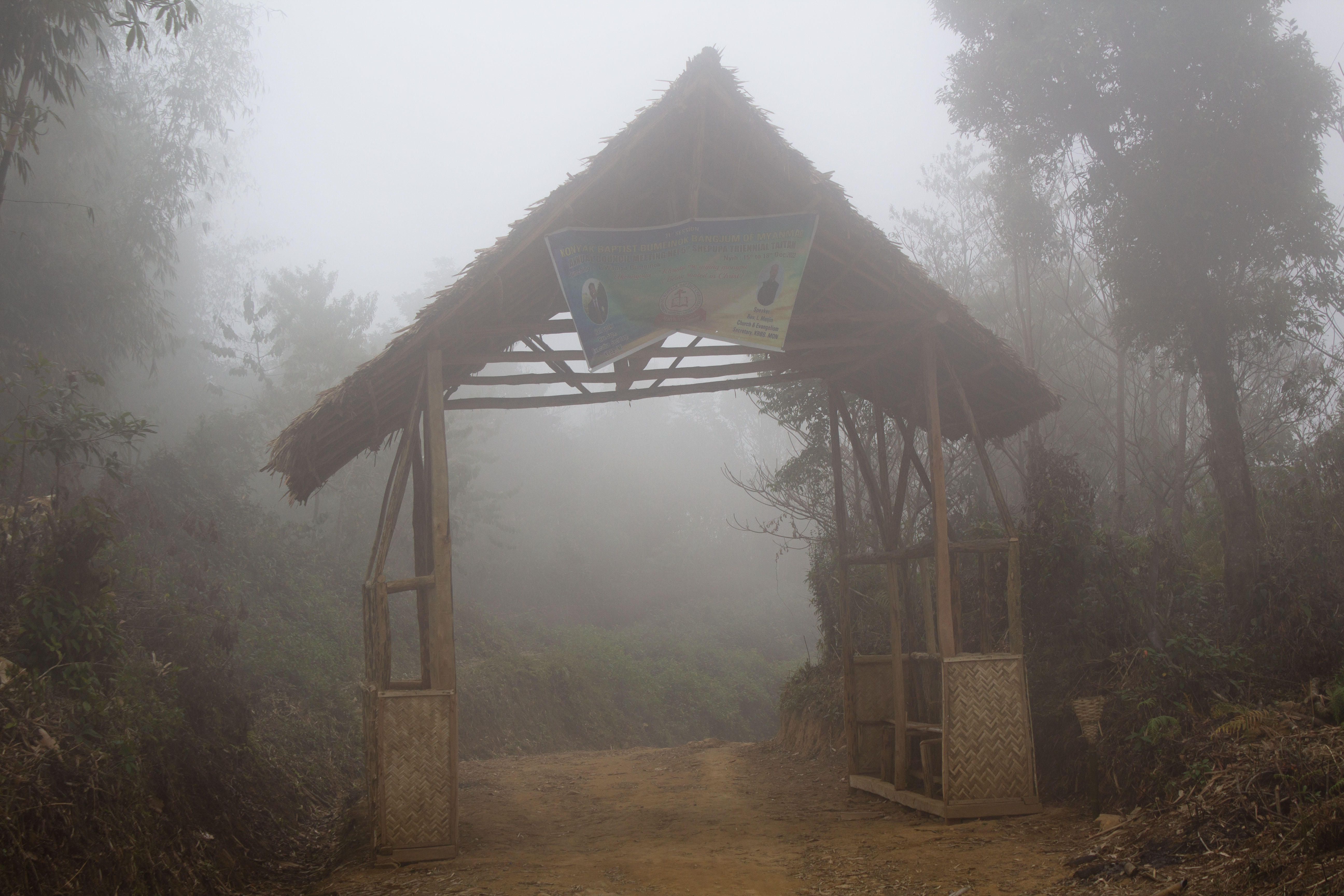
The gate of Longwa-Wasa in the mist. The sign is announcing some sort of big Baptist church meeting with a visiting pastor from Burma.
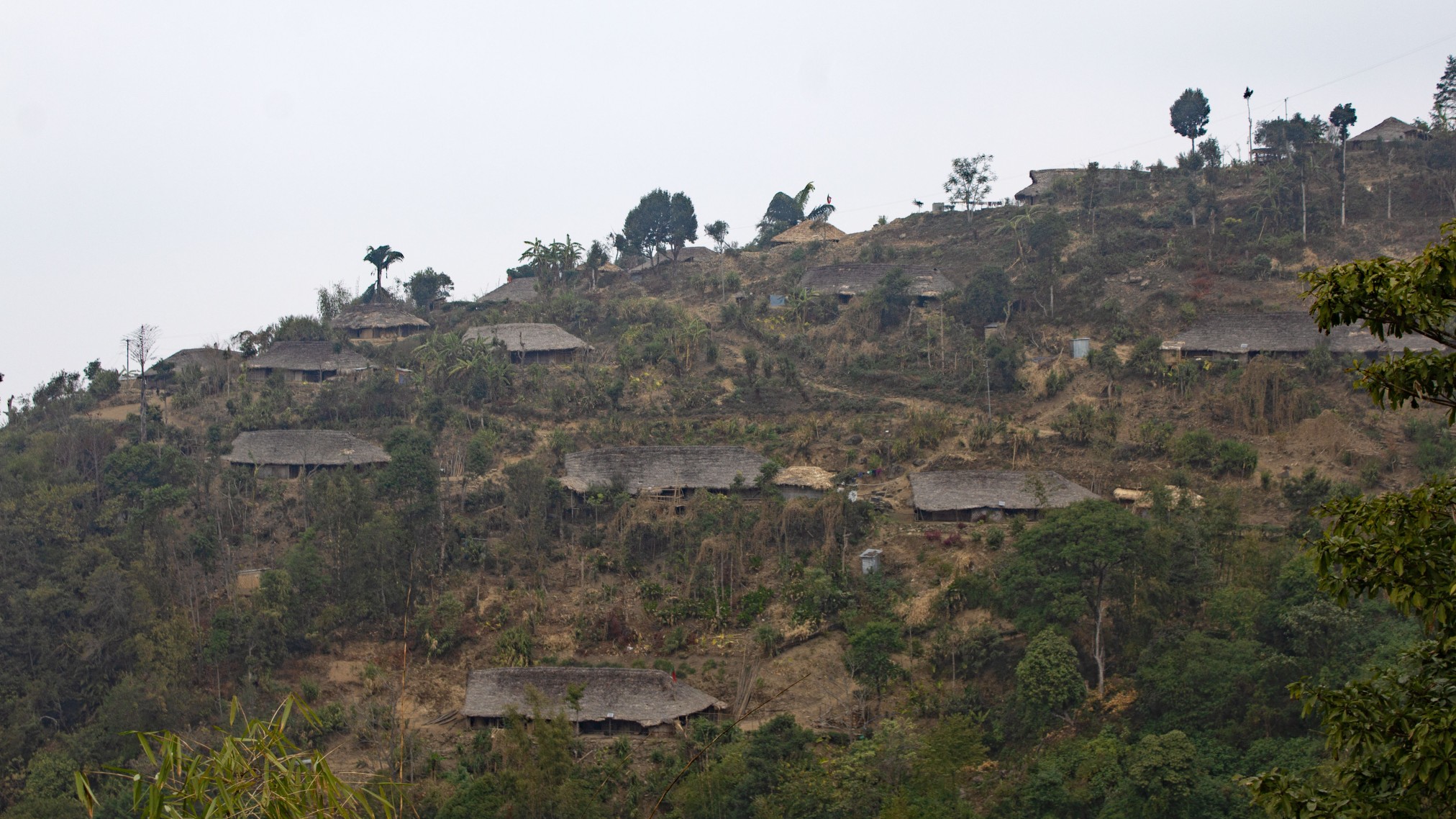
Longwa-Wasa. But for the occasional power cable and bit of concrete, this photo could have been taken 100 years ago.
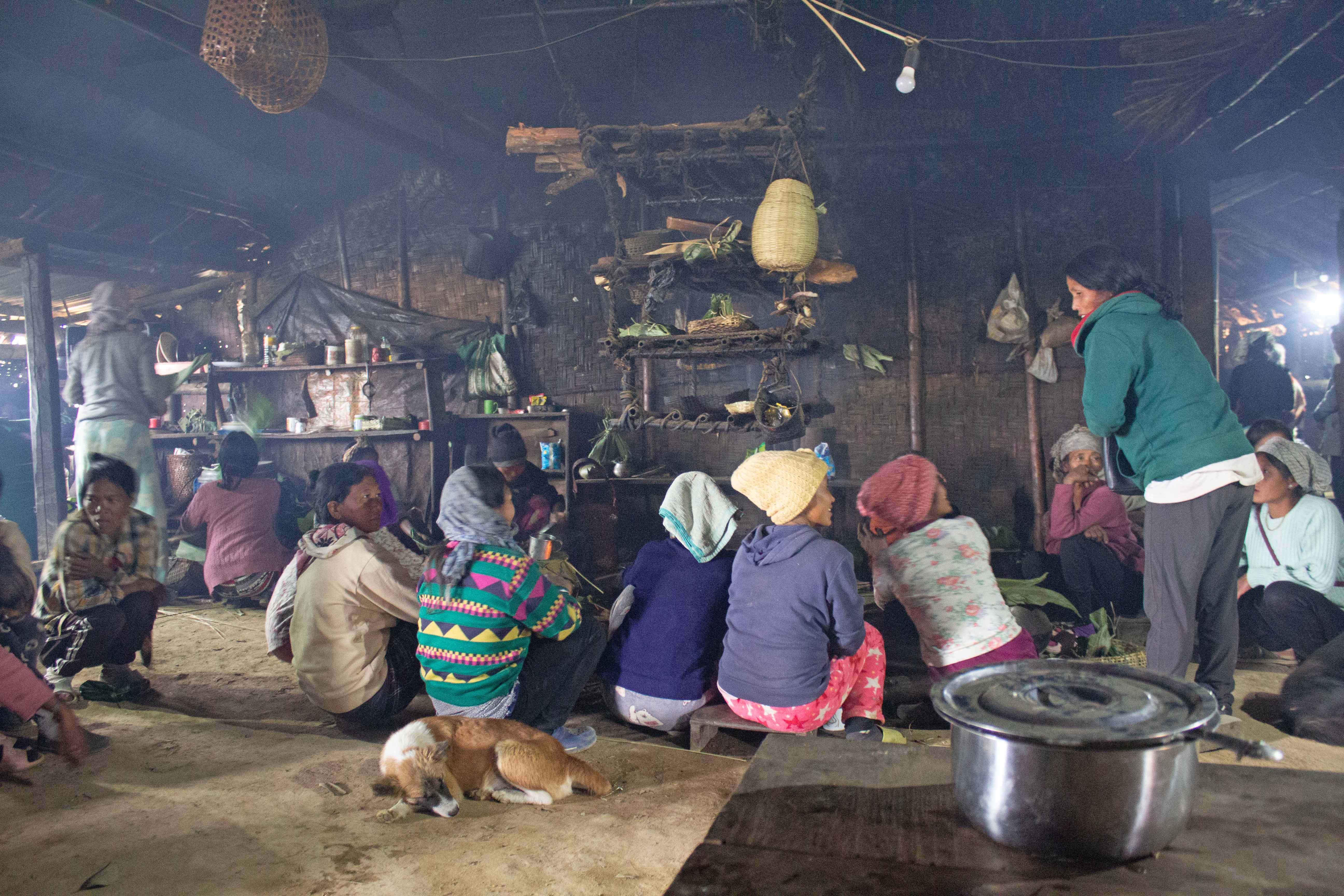
Wedding party in Longwa-Wasa.
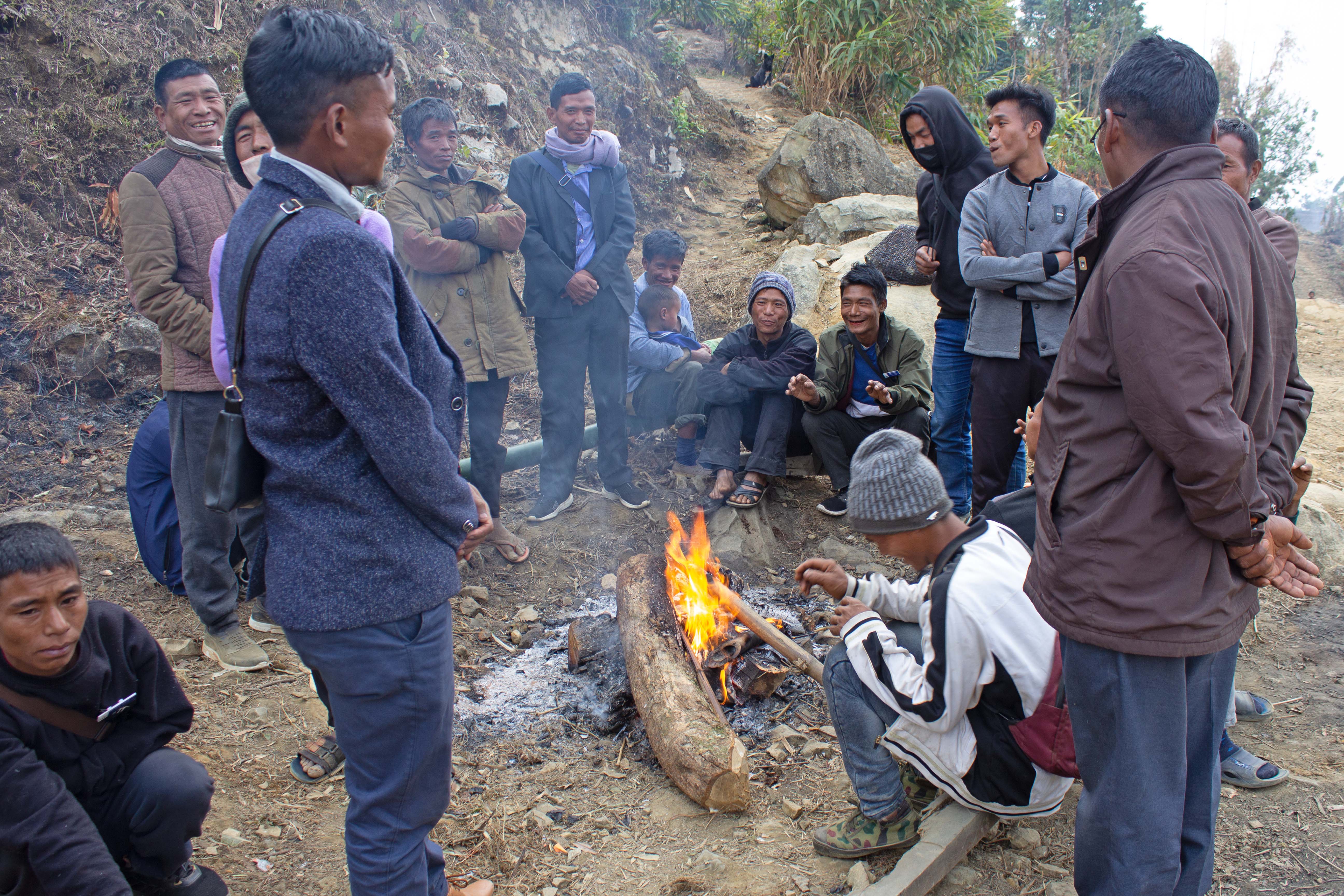
Goofing off around a fire.
If you enjoyed this post, please consider supporting me on my Patreon page. There, you can download an extended edition of my book The Green Unknown which includes several chapters available exclusively on Patreon.
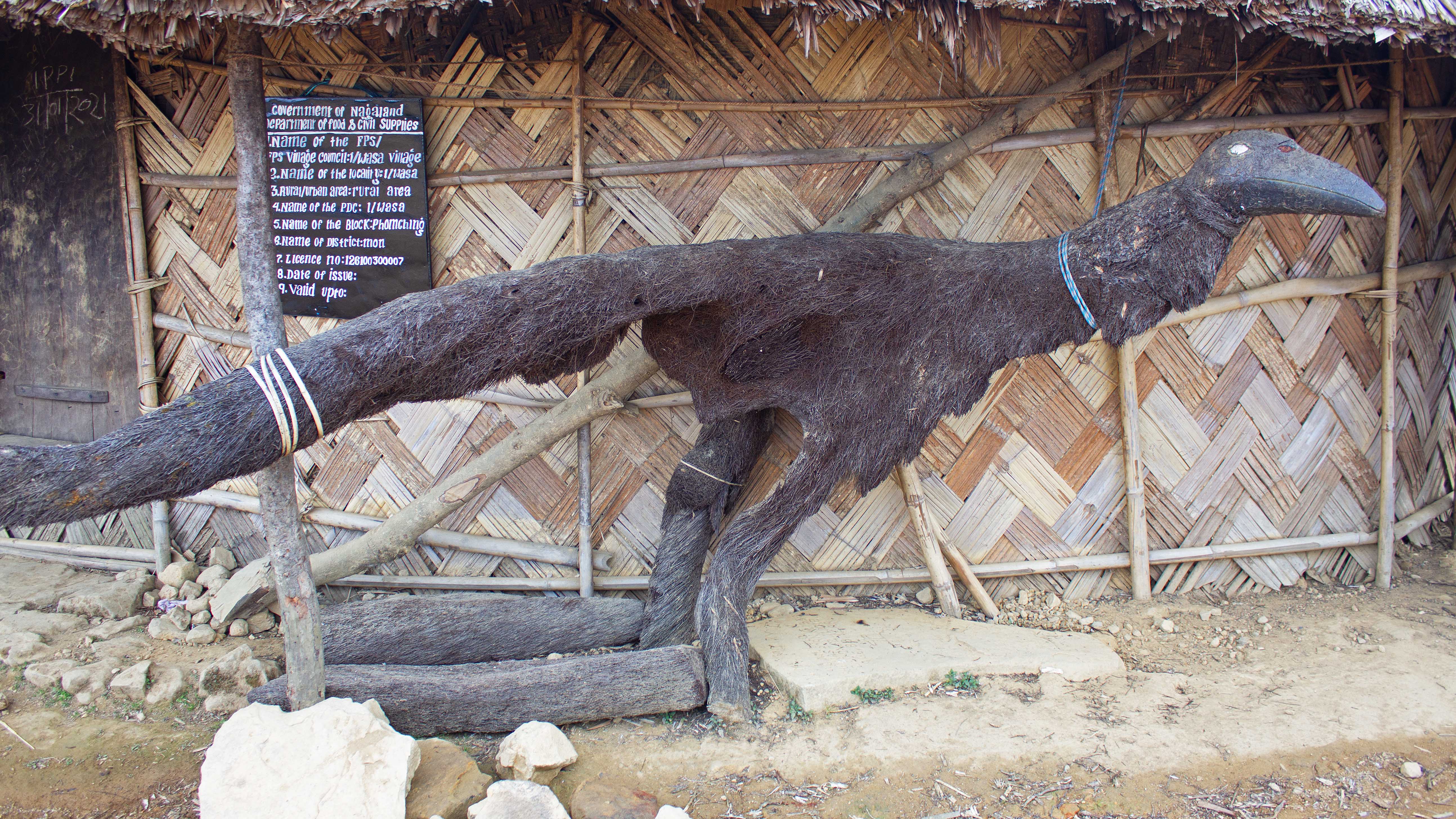
Here’s a bizarre giant bird in Longwa-Wasa. I’m sure you’ve read that last sentence many times in your life.
